Orthodontic Troubleshooting
Orthodontic emergencies occur occasionally and although they may be a little upsetting for the patient and parents, they are usually fairly simple to treat.
1) If there is a breakage with minimal or no discomfort, then please call during office hours and an appointment will be scheduled within the next few days for a repair.
2) If you call outside our regular office hours, you may leave a message and a staff member will return your call as soon as possible. During Christmas holidays the repair may sometimes be delayed for 2 - 3 weeks until the office re-opens.
3) If the patient is experiencing discomfort some practical tips are provided below to help you manage your orthodontic problem until you are able to have it repaired.
* If, for some reason, you are unable to schedule an appointment to see us (for example if you are travelling or if our office is closed during staff conferences or holiday periods), your local dentist can often assist with your problem.
* We advise that your dentist adjust or remove any irritating factor. We are not concerned about damage to the braces in this case; the priority is to provide patient comfort and relief. The proper repair to the braces can then be scheduled within the next few days or weeks when our office re-opens.
* If the trouble has occurred during the holiday period or after hours and your regular dentist is unavailable, the Australian Dental Association has provided a link on their website that may assist you with locating a dentist in your area.
*If you have read through the Orthodontic Troubleshooting page below and still require urgent attention over the Christmas break, you may call a staff member at home on 0404843438 between 9am and 5pm.
Trauma to the Face or Teeth
If a patient has received a blow or trauma to their mouth, such as a sport injury, it is important that you see your regular dentist BEFORE you contact Hills Orthodontics. Your dentist will do the appropriate diagnostic tests and provide first aid for any damaged teeth. You can then contact your orthodontist to arrange a repair of any damage to the braces.
If the trauma has occurred during the holiday period or after hours and your regular dentist is unavailable, the Australian Dental Association has provided a link on their website that may assist you with locating a dentist in your area..
Irritation of Lips or Cheeks
Sometimes new braces can be irritating to the mouth. This is usually temporary; however in the meantime using orthodontic wax can provide some relief.
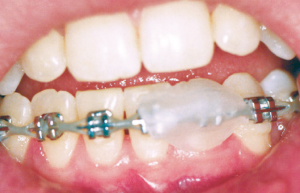

If during treatment, any part of the braces is sharp and causing irritation, putting a buffer between the metal and the cheek to move the cheek away from the metal will provide some relief in the short-term until you can see your orthodontist. Orthodontic wax can be used to provide a buffer and some other alternatives are suggested below.
Using Orthodontic Wax:
- Drying the braces before applying the wax will help it stick better.
- Pinch off a small piece of wax and roll it into a ball. Flatten the ball and wedge the wax over and around the area of the braces causing irritation. The less wax you use, the less likely it is to dislodge during mouth function and the longer it will stay on.
- Warming the wax in your fingers will make it softer, stickier and easier to apply.
- If the area of irritation involves several teeth, you can flatten the wax into a thin long tape and wedge it over several brackets as a single strip.
Alternatives to Orthodontic Wax:
- If you do not have orthodontic wax, sugar-less chewing gum can be used to temporarily act as a buffer between the cheek and the braces.
- If you cannot get the wax to stick, or the orthodontic appliance is too bulky to place wax on, you may use a cotton make-up removal pad or something similar (folded-up napkin or tissue) to hold the cheek away from the braces. Roll up the pad, cut it to size, and place it between the cheek and the braces.
Wire Irritations
- Small, fine wire known as a ligature is sometimes used to hold the main thicker arch-wire in place. These are usually located more towards the front or sides of the braces. If a ligature is out of place, sometimes a cotton Q-tip or pencil eraser can be used to push the wire back into a more comfortable position. This can also be helpful if a part of the metal braces is poking inwards towards the tongue.
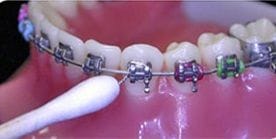
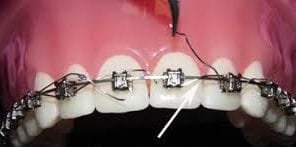
- Occasionally, the end of the main arch-wire will work itself out of place and poke out causing irritation (this often occurs at the very back of the braces). Try covering the end of the wire with a small amount of wax. It may also be helpful to place some type of buffer between the wire and the cheek (see "Irritation of Lips or Cheeks" above).
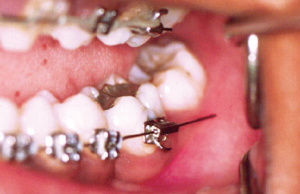
- In a situation where the wire is extremely bothersome, as a last resort, you may clip the wire using a pair wire cutters or sharp nail clippers. Any damage to the braces can be repaired by your orthodontist; the priority is patient comfort. Please then contact our office and a time will be scheduled for a repair.
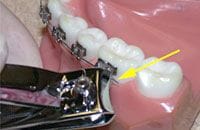
Loose Bracket
Brackets are the part of braces attached to teeth with a special adhesive. The bracket can be knocked off for various reasons and does not usually cause discomfort. Loose brackets may be discarded, or rotated back into a more comfortable position on the wire (tweezers can be helpful) until an appointment can be arranged. Wax can also be placed over the loose bracket if it is irritating. If any brackets become loose and you are currently wearing elastics, please stop wearing all elastics until your next visit.
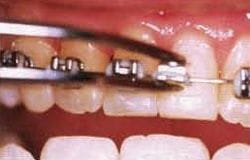
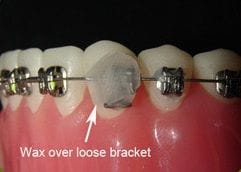
Power chain
Either clear or grey (or if you have had it on for a while it will be a discoloured yellow) elastic connected links (latex free) going from bracket to bracket.
If this comes off you can remove the entire chain or simply cut what has come off. Please refer to our video for a demonstration of this.

Missing O'rings
These are the coloured elastics that go around the brackets which in turn hold the wire in place.
If you notice any of your colours missing or have come off then you can just leave them off.
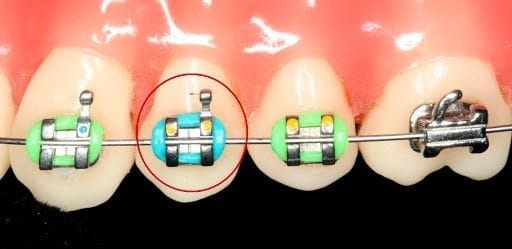
Loose Coil
Coil is often placed between a set of brackets. Sometimes the coil can unwind itself and stick out. When this happens it can cause irritation to the lip/cheek. Please refer to instruction video below.
Loose Bands, Loose Expanders, Loose Crowns
Occasionally a metal band or metal crown can come loose from a back tooth. The band can sometimes also be part of an expander or another appliance. If possible, gently push the loose ring back into place then contact our office to arrange a repair appointment.
Loose Baby Teeth and Brackets
When early orthodontic treatment is undertaken in primary school, braces can also be attached to baby teeth. Sometimes these baby teeth can become loose during treatment. This may be associated with the normal discomfort and bleeding that occurs when baby teeth are lost. If the baby tooth is loose and still attached to the braces- do not worry. At your next appointment your orthodontist will either free the loose baby tooth or advise to just leave it in place for the time being.
Lost Separators
Many patients lose a separator at the start of treatment. Do not worry as it is normally the result of the space opening. If you lose a separator contact the surgery so we can assess what action to take.
Discomfort
It is normal for a patient to have discomfort for a few days after braces are fitted or adjusted. It can make eating uncomfortable, especially harder foods. This discomfort is both normal and temporary. If the patient is allowed to have over-the-counter pain relievers, then a regular dose of Nurofen or Panadol would normally be effective. A soft diet is also recommended.
Mouth Ulcers
Mouth ulcers can sometimes be related to rubbing from the braces. In this case, a buffer, such as orthodontic wax, should be placed between the braces and the cheek or tongue (see "Irritation of Lips or Cheeks" above). Other times ulcers can occur in areas of the mouth unrelated to the braces. Prompt relief may be achieved by applying a small amount of topical anaesthetic (such as Orabase or Ora-Gel or Bonjela) directly to the ulcerated surface. This should be reapplied as needed. Warm salt water mouth rinses are also very helpful.
Forsus Springs
These bite correction springs can make the teeth and jaws feel tender for a few days. If the patient is allowed to have over-the-counter pain relievers, then a regular dose of Nurofen or Panadol would normally be helpful.
It may be more difficult to chew food. It is recommended to eat softer foods while adjusting to the Forsus. You may find cutting your food into smaller bite-sized pieces is easier than biting into foods.
The rods may make the inside of the cheeks a little sore. Place a cotton roll, folded tissue or make-up pad between the cheek and rod/spring to provide a buffer for the cheeks. Occasionally, mouth ulcers can develop in which case warm salt water rinses and topical anaesthetic can be used.
If a bracket becomes loose, please contact our office to arrange an appointment as soon as is convenient.
If the rod becomes separated from the spring (sometimes during yawning or opening the mouth too wide) try to re-engage the rod by compressing the spring and inserting the rod into the spring.
If any of the parts of the Forsus (ie, rod or spring) disconnects from the braces please remove the loose pieces to avoid swallowing and contact our office to arrange an appointment as soon as is convenient. If possible, please bring the pieces with you to your appointment.
Some additional helpful tips for Forsus are shown in the video link below.
Breakages of fixed retainers (ie, wires bonded behind your teeth)
If your fixed retainer is loose but is still comfortable and you are currently wearing clear removable plates at night, you may continue to wear your removable plates every night until we are able to repair your fixed retainer.
If you fixed retainer is loose and the wire is causing some discomfort (eg, poking wire), you may try to cut the wire with nail clippers or sharp nail scissors. If you are currently wearing clear removable plates at night, you may continue to wear your removable plates every night until we are able to repair your fixed retainer.








